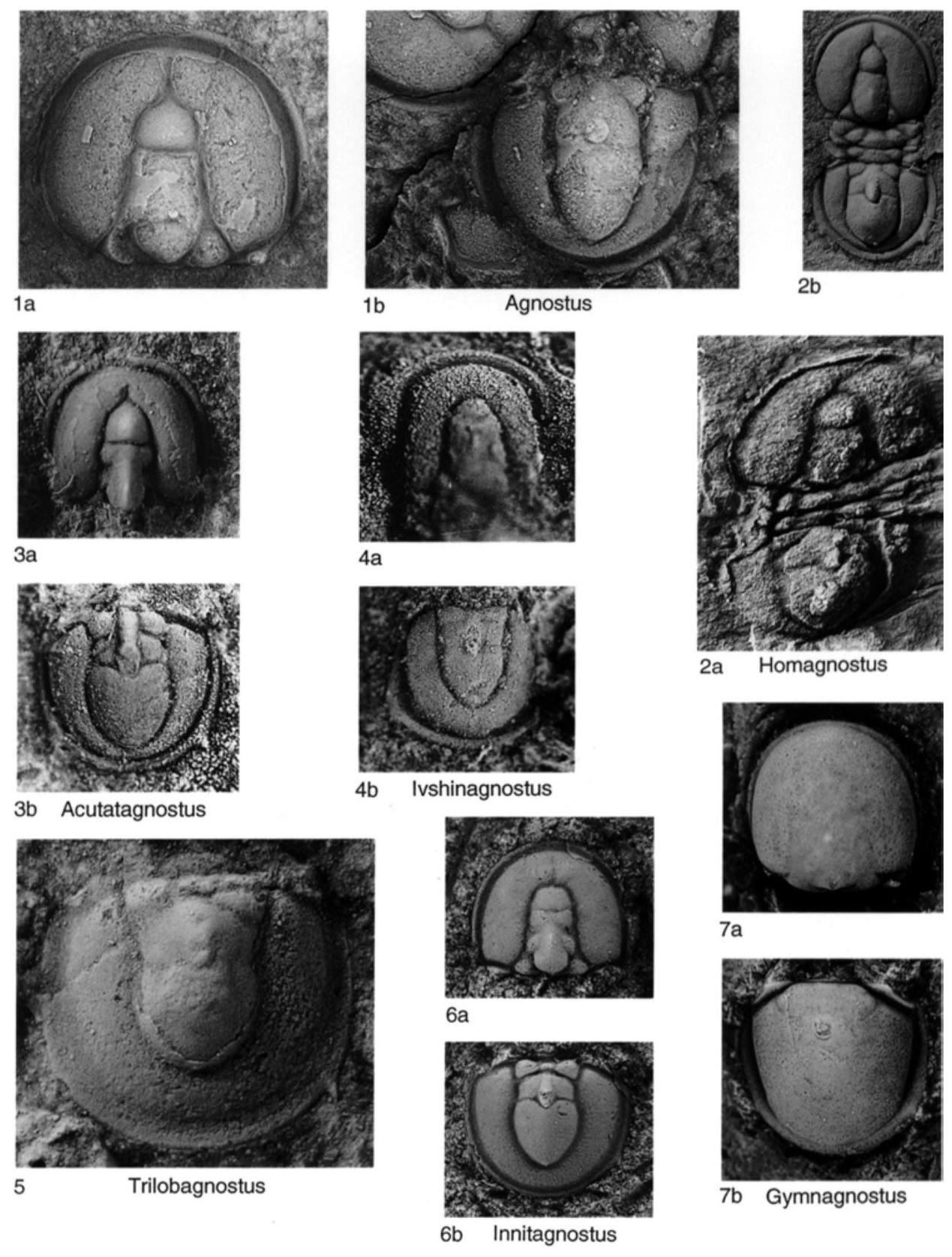Welcome to the Treatise on Invertebrate Paleontology!
Please enter a genera name to retrieve more information.

Homagnostus
Classification
Phylum:
Unknown
Class:
Trilobata
Order:
Agnostida
Superfamily:
Agnostoidea
Family:
Agnostidae
Formal Genus Name and Reference:
Agnostus (Homagnostus) HOWELL, 1935c, p. 15
Type Species:
Agnostus pisiformis Linnaeus var. obesus Belt, 1867, p. 294, OD, lectotype (Belt, 1867, pl. 12, fig. 4a, SD Rushton in Allen, Jackson, & RUSHTON, 1981, pl. 16, fig. 2), I.7646, BMNH, London
Images
(Click to enlarge in a new window)
Fig. 217,2a,b. *A. (H.) obesus (Belt), Upper Cambrian (Olenus Zone), a, lectotype, northern Wales (Afon Mawddach, Dolmelynllyn), X8 (Allen, Jackson, & Rushton, 1981, pl. 16, Fig. 2), b, exoskeleton, BMNH TE6, England (Nuneaton district), x6.67 (Rushton, 1978, pl. 25, Fig. 4).
Synonyms
A. (Homagnostus)
Geographic Distribution
northern Greenland, England, Wales, O. gibbosus-O. cataractes Subzones, Sweden, Norway, Denmark, Olenus Zone, Russia (Novaya Zemlya, Yakutia, Altay Mountains), Kazakhstan, Pedinocephalina/ToxotisIrvingella Zones, China (Zhejiang, Shandong, Liaoning), G. stolidotus Zone, South Korea, Chuangia Zone, Australia (Queensland), G. reticulatus Zone, USA (Alabama, Alaska, Oklahoma, Texas, Nevada, Wyoming), AphelaspisElvinia Zones, Canada (Newfoundland, Northwest Territories), ?Cedaria minor and Irvingella major Zones
Age Range
Beginning Stage in Treatise Usage:
Upper Cambrian
Beginning International Stage:
Guzhangian
Fraction Up In Beginning Stage:
50
Beginning Date:
498.75
Ending Stage in Treatise Usage:
Upper Cambrian
Ending International Stage:
Cambrian Stage 10
Fraction Up In Ending Stage:
100
Ending Date:
486.85
Description
Pygidium with posteriorly broadly rounded axis extending nearly to posterior border furrow, Axis constricted across M2 with posterior lobe variably but always laterally expanded, F2 well developed, F1 always impressed laterally and only occasionally impressed medially, M1 variably tripartite
References
Museum or Author Information
Classification
Phylum:
Unknown
Class:
Trilobata
Order:
Agnostida
Superfamily:
Agnostoidea
Family:
Agnostidae
Formal Genus Name and Reference:
Agnostus (Homagnostus) HOWELL, 1935c, p. 15
Type Species:
Agnostus pisiformis Linnaeus var. obesus Belt, 1867, p. 294, OD, lectotype (Belt, 1867, pl. 12, fig. 4a, SD Rushton in Allen, Jackson, & RUSHTON, 1981, pl. 16, fig. 2), I.7646, BMNH, London
Images
(Click to enlarge in a new window)
Fig. 217,2a,b. *A. (H.) obesus (Belt), Upper Cambrian (Olenus Zone), a, lectotype, northern Wales (Afon Mawddach, Dolmelynllyn), X8 (Allen, Jackson, & Rushton, 1981, pl. 16, Fig. 2), b, exoskeleton, BMNH TE6, England (Nuneaton district), x6.67 (Rushton, 1978, pl. 25, Fig. 4).
Synonyms
A. (Homagnostus)
Geographic Distribution
northern Greenland, England, Wales, O. gibbosus-O. cataractes Subzones, Sweden, Norway, Denmark, Olenus Zone, Russia (Novaya Zemlya, Yakutia, Altay Mountains), Kazakhstan, Pedinocephalina/ToxotisIrvingella Zones, China (Zhejiang, Shandong, Liaoning), G. stolidotus Zone, South Korea, Chuangia Zone, Australia (Queensland), G. reticulatus Zone, USA (Alabama, Alaska, Oklahoma, Texas, Nevada, Wyoming), AphelaspisElvinia Zones, Canada (Newfoundland, Northwest Territories), ?Cedaria minor and Irvingella major Zones
Age Range
Beginning Stage in Treatise Usage:
Upper Cambrian
Beginning International Stage:
Guzhangian
Fraction Up In Beginning Stage:
50
Beginning Date:
498.75
Ending Stage in Treatise Usage:
Upper Cambrian
Ending International Stage:
Cambrian Stage 10
Fraction Up In Ending Stage:
100
Ending Date:
486.85
Description
Pygidium with posteriorly broadly rounded axis extending nearly to posterior border furrow, Axis constricted across M2 with posterior lobe variably but always laterally expanded, F2 well developed, F1 always impressed laterally and only occasionally impressed medially, M1 variably tripartite
